Apple iPhone 4 Review

iPhone 4 - not an easy thing to review. Most readers know that in the world of gadgets, any new device from Apple is a big event, preceded by numerous rumors, speculation, and then - days, weeks, or even months of anticipation. Definitely, the iPhone 4 is no exception. Perhaps even for Apple it was the most successful product launch. We have already seen how the Apple and AT & T servers were overloaded on the first day of pre-orders, and how the date of the next batch of pre-orders was postponed due to the huge demand. We also saw ardent fans not far from Apple stores, which spread out their tents a week before the phone went on sale.
And the iPhone 4 does not seem to let us down - with all the new features, like a super-high-speed A4 processor, a new camera on the front side and a five-megapixel rear, a completely new industrial design, and this crazy screen - Retina Display. No one dares to say that Apple was relaxing.
')
In general, the question arises - does the iPhone 4 really deserve all this hype? Will he be able to fulfill the promises of Steve Jobs made at WWDC and strengthen Apple's position in the market in the face of opponents like Google and Microsoft?
We have the answers to these - and many more - questions. In this review.
Iron
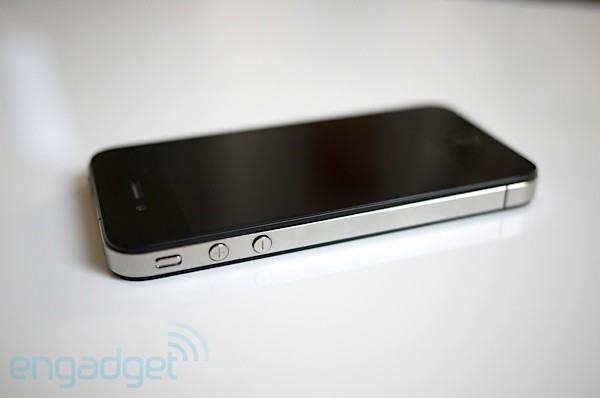
Perhaps the most significant change in the new iPhone was the revision of the design in favor of the radical industrial - it seems that Apple has completely changed its mind about how the phone should look and be felt, and the result, as it were, is amazing, amazing.
Industrial design
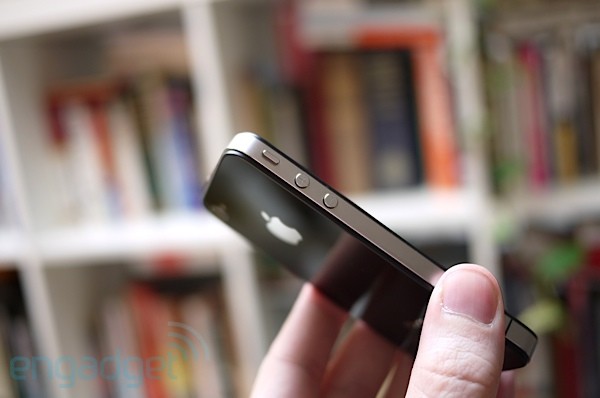
In his presentation at WWDC, Steve Jobs compared the design of the iPhone 4 with the “good old beautiful Leica camera”, and this is not far from the truth. Instead of working on a streamlined, plastic appearance (as in the iPhone 3G and iPhone 3GS), the company decided to make the device case much more complex and detailed. The iPhone 4 is made up of three main parts: two pieces of polished reinforced glass, and a stainless steel frame between them. Plus all sorts of small details, like the volume buttons, and the seams on the metal frame (more on that below). The phone is noticeably thinner than the same iPhone 3GS (.37 inches vs. .48), but it weighs the same, so it feels more “knocked down”, solid and dense. In his hand, he is just fine, though it will take a little time to get used to the sharp edges, if you used to have 3G or 3GS.

It seems difficult to overplay how cool the design of the iPhone 4 looks. After it, the 3GS looks plump and cheap, and even a phone like the HTC Droid Incredible - which just came out - looks like a “previous generation”.
So, as mentioned above, the phone consists of three main parts. The front side of the device is made of very durable glass, which Johnny Ive described as “comparable in strength to sapphire crystal, and 30 times harder than plastic.” A small cut in the glass on top is designed for the speaker, and the familiar Home button is still there, below the screen. On the left side of the phone are updated volume buttons and a new silent mode switch. On the right side is a Micro SIM slot, on top is an on / standby button, a headphone jack and an optional noise canceling microphone. Bottom - speaker, microphone and 30-pin connector. The back side of the phone is made of the same ultra-durable glass, it has only a new five-megapixel camera with LED flash, and, of course, the Apple logo.

Summing up, we can say that the iPhone 4 is superior to any other smartphone among those that are currently on the market, if we talk about design. It looks like a much more expensive device than it actually is, something like Mobiado or Vertu - only the design is even better. And it's not just what it looks like; materials are very pleasantly felt in the hands - this is clearly a premium class. The first few days that we had this phone, simply did not want to let go of it, and it says a lot about how really beautiful and pleasant it is to use.
Insides
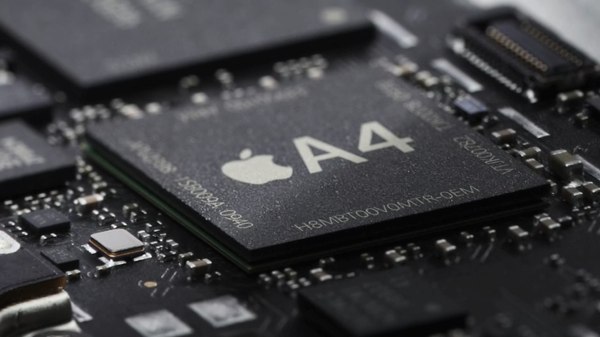
Not only the outside has undergone changes - iPhone4 is completely redesigned inside. For starters, Apple replaced the old Samsung processor, based on ARM Cortex-A8, which was used in the iPhone 3GS, with its own A4 chip (the same one that is inserted into the iPad), which is quite funny in itself, because it is ... again same ARM Cortex-A8 based processor. The company does not say what its clock frequency is, but we assume it is something like 1GHz. The phone has definitely become faster than the 3GS, in particular, the graphics are processed faster and the overall responsiveness of the device is higher. It is clearly faster than the 3GS, but since the 3GS itself was quite fast, the difference is not as noticeable as it was when switching from 3G to 3GS.
The iPhone 4 has 512 megabytes of RAM onboard, which is a serious step compared to 256 megabytes in previous models and in the iPad. And as for the memory for user data - now you can buy an iPhone with 16 or 32 gigabytes of memory - which is not bad, but since the company just introduced the ability to record 720p video with 30 frames per second, it is possible that this reserve will be quickly exhausted. It is a little strange that the company did not double the amount of maximum memory (up to 64 gigabytes), as was done recently with iPod touch. Well, as for wireless communications, the iPhone 4 has Wi-Fi 802.11n support, four-standard HSUPA and, of course, Bluetooth 2.1.

Recycled internal layout allowed to put in the phone a lithium-ion battery with greater capacity than before. In addition, the new phone has two cameras built in (VGA on the front panel, and a five-megapixel camera with LED flash at the back), a new additional microphone for noise reduction (like the one in the Nexus One), a gyroscope in the appendix to the standard accelerometer, light sensor and sensor proximity. Like the 3GS, an AGPS chip is built in here.
And a few words about antennas. Apple made a steel frame around the phone a sort of big antenna for all wireless interfaces. The big question is will help fix endless dropped calls in an AT & T network environment? Well, according to our tests, we did a lot, much less drop calls, than it was on the 3GS. That is, we repeat: yes, the iPhone 4 seems to have really overcome the problem of dropping calls on the AT & T network. However, we had several problems, in the center of New York, in particular, but it’s hard to say whether the problem was in our phone, or in the surrounding buildings, or in our subscribers, who had 3GS.
Screen

Most likely, at the moment you already know that an absolutely new screen has appeared in the iPhone 4. Apple calls its 960x640 IPS display with LED backlight - “Retina Display” due to its high pixel density. On the same 3.5-inches as on previous screens, the new display offers an insane density of 326ppi and a contrast ratio of 800: 1. Steve made a loud statement at the conference about the scientific side of technology, saying that the screen resolution exceeds the resolution of the human eye. There was a lot of controversy about this statement, but what we can say for sure: our eyes have never seen a more detailed and clear screen on any mobile device.
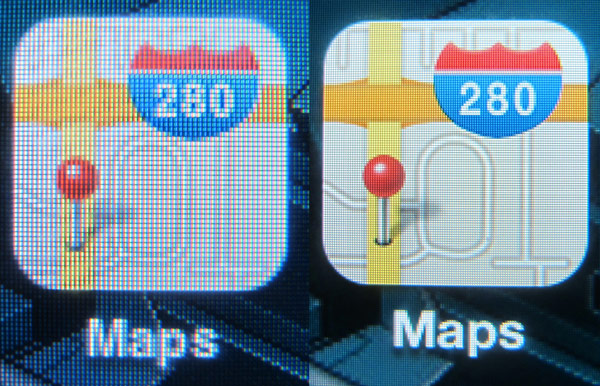
Not only did the colors become deep and rich, but we really can't distinguish the pixels on the screen. Yes, if you take a macro camera, then everything can be distinguished, but in real life no “steps” are visible on the screen. The text is rendered surprisingly clear and clean - the web pages that used to be just a string of pixels (on 3GS) are absolutely readable on the new phone without magnification, although the font looks microscopic. It is impressive. And even more impressive when you view hi-res photos or watch 720p video on your phone - all the details are simply amazing. And that is very good - the text in all applications, even if the authors do not bother to update them, will look great, because their interface uses a single font display system.

Summarizing, we can say that you simply will not find any display on any phone better, and these are not empty words.
Cameras

Cameras in the new iPhone will clearly cause numerous discussions, because this is an area in which Apple was in no hurry to progress earlier. The 3GS had a three megapixel camera without flash, which was good for fast shots, but no more. But the company seems to have finally listened to users, and added a five-megapixel camera in the back and a VGA camera in the front.
Let us first deal with the one that is better. At WWDC, Jobs said that in order to take great pictures, it’s not enough just to increase the number of megapixels. To make the pictures look better, you need to increase the amount of light, so that more light falls on the matrix. In short, Apple uses a new back-illuminated sensor (backside-illuminated), which is significantly more sensitive to light. Well, more megapixels did too. And what can we say? Photos from the iPhone 4 look stunning! In addition, the phone is able to make absolutely suitable (and sometimes even cool) pictures in low light conditions without flash. It seems that everything that was said about “the amount of light” really played a role. Autofocus works well in most cases. In general, we had no problems using the camera in the iPhone 4: in addition, A4 and iOS 4 tandem significantly increased the speed of the photo - now everything happens almost instantly.
As for shooting video in 720p mode, in short: everything we shot looked very clear and (in most cases) without any artifacts.
The camera that is in front ... well, this is a VGA camera. It removes your face well during video calls, and works surprisingly well in low light conditions, but, of course, it won no prize in the competition of the best cameras. In general, everything is fine with a small camera, nothing special.
Speakers
We have never had any problems with the speakers on previous generations of the iPhone (although it can be said that the speaker was not always as loud as we would like), but it is obvious that Apple has done its job here, raising the quality of the speaker for conversations and dynamics calls. In addition to the fact that the volume of both speakers has grown, the clarity of their sound is noticeably improved. Maybe you already know that until now the Motorola Droid had one of the best audio tracks of all the phones that we heard, and so, the new iPhone definitely gives it a head start. When we first called from him, we walked along one of the most noisy places in New York - on Fifth Avenue, and even then it was noticeable that the additional microphone for noise cancellation does its job - even the sirens around us did not interfere with hearing each other perfectly . The difference between the old 3GS and the new iPhone 4 in terms of sound quality is quite obvious, and moreover, we consider it significantly better than the new HTC EVO.
Software

As with previous Apple phone upgrades, hardware is only half the battle. Together with iPhone 4, iOS 4 comes out - a new version of the operating system with a huge number of new features, the largest of which are multitasking, video calls, folders, an improved Mail application, and so on. In addition, Apple ported the iBooks application from the iPad to a small screen and even made a new version of its popular iMovie application for the iPhone 4. Overall, the operating system is still largely the same as it was before, but received several major changes. about which you need to tell.
Multitasking
This is a big topic of conversation. Since the birth of applications on the iPhone (remember the 2008th?), People have resented the lack of multitasking (for third-party applications). Of course, you could keep Mail, Safari, iPod and several other programs from Apple itself in photo, but other developers were not worthy of these privileges. Arguments of the company was that multitasking always badly affects the lifetime of the phone from the battery charge. And in the end, Apple introduced with its own way -
“As it really should be” - multitasking. But the programs were not allowed to hang completely in the background, but were limited to several services, such as receiving GPS signals, playing music, communicating with VoIP, and organized a quick switch between tasks.
And what came of it? Will this make normal multitasking? If you answer in one word, then: yes.
The bottom line is that maybe this is not the most “real” multitasking, but for the vast majority of us this will be enough. Everything looks and feels like it's “real” multitasking.
(From the translator: I have to apologize, the text is cut down. I don’t want to turn the phone review into a regular review of iOS 4 features)
Battery
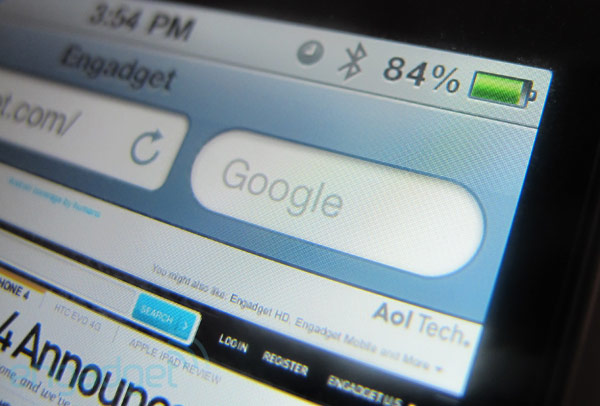
For many people, this item is very important, and we have a couple of surprises. Battery in the new iPhone 4 exceeded our expectations. The phone lasted 38 hours - yes, 38 hours - in (our) real life, when we made calls, played games, received a lot of email (via push notifications) and calendar invitations, played music through a Bluetooth connection in the car, and carried out endless tests (downloaded new applications, moved icons, changed settings). In the new phone they put a larger battery, and paired with an A4 processor, it gave a good boost.
As soon as we have the opportunity to test the battery better, we will do it, but we think that iPhone 4 has left behind the phones of previous generations.
Conclusion
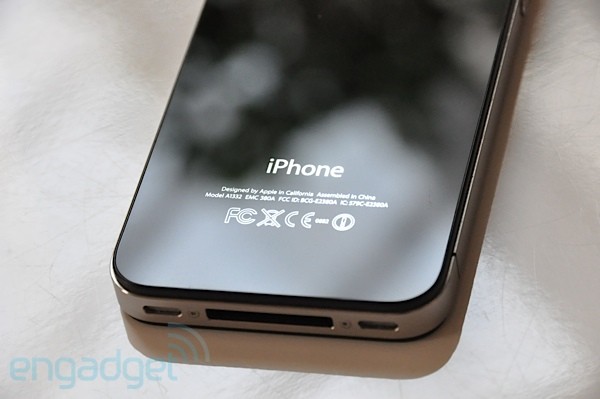
We will not beat around the bush - in our opinion, the iPhone 4 is the best smartphone today. This phone is a combination of a great new hardware, this amazing display, updated cameras, and major improvements in the operating system. Yes, there are still some nuances that we would like Apple to fix, and yes, there are some good alternatives to the iPhone. But when you see this product in its assembled form — whole, complete software and hardware, its performance, a huge selection of applications, and many other small details — we think it is the cream of everything that exists. We will not argue about taste - some people just prefer the style of Android or Sybmian work - but the overall picture is that it is very difficult to deny that Apple has left one step behind all its competitors with this phone. But, of course, in this ever-changing smartphone market, it’s hard to predict how long they will hold the advantage and whose device will become the Next Big Thing.
Original article by Engadget .
Source: https://habr.com/ru/post/97246/
All Articles